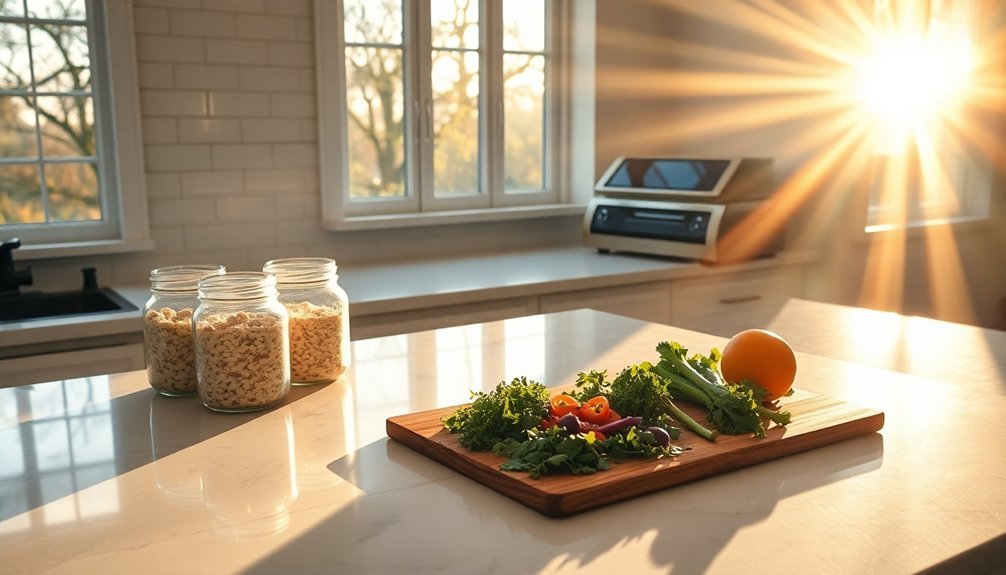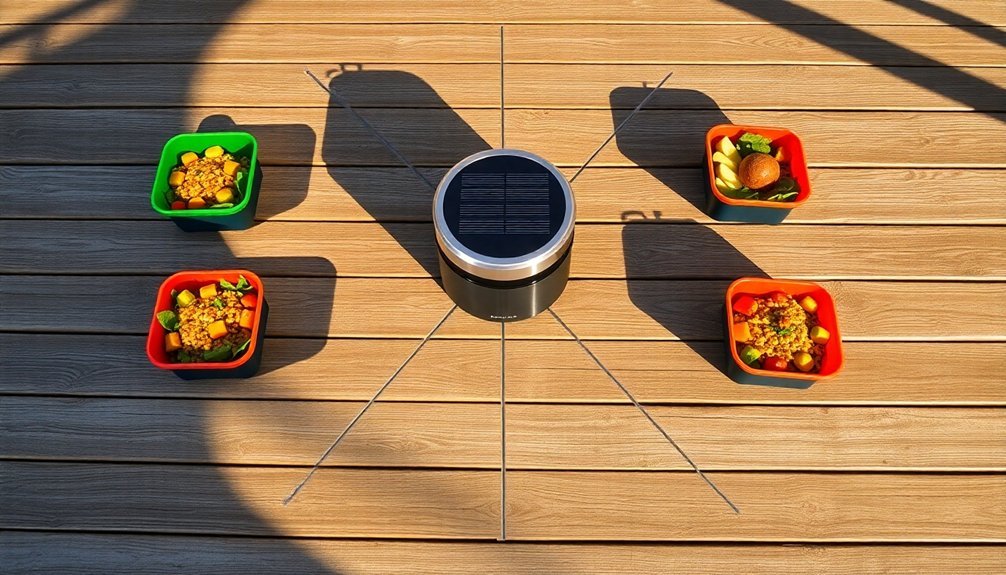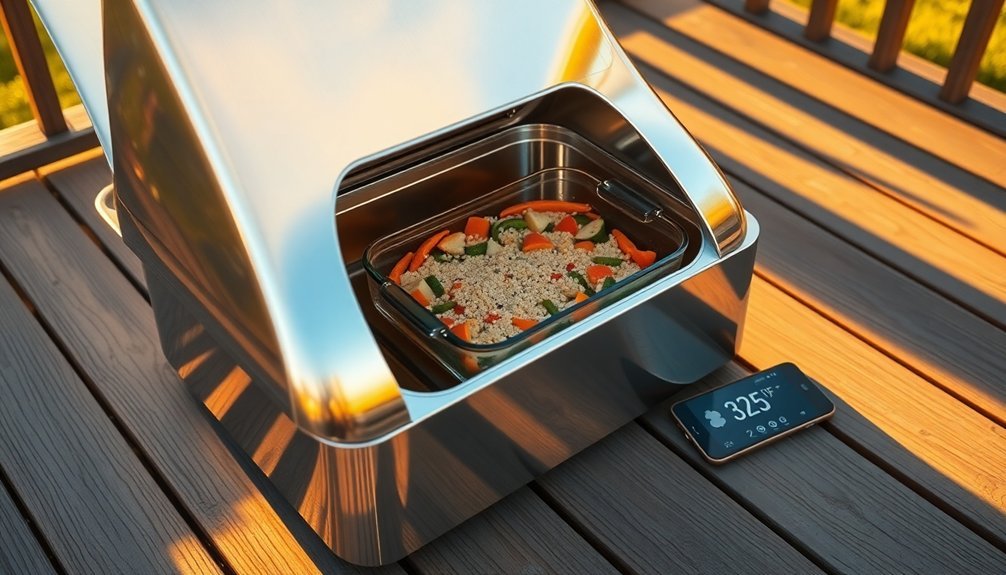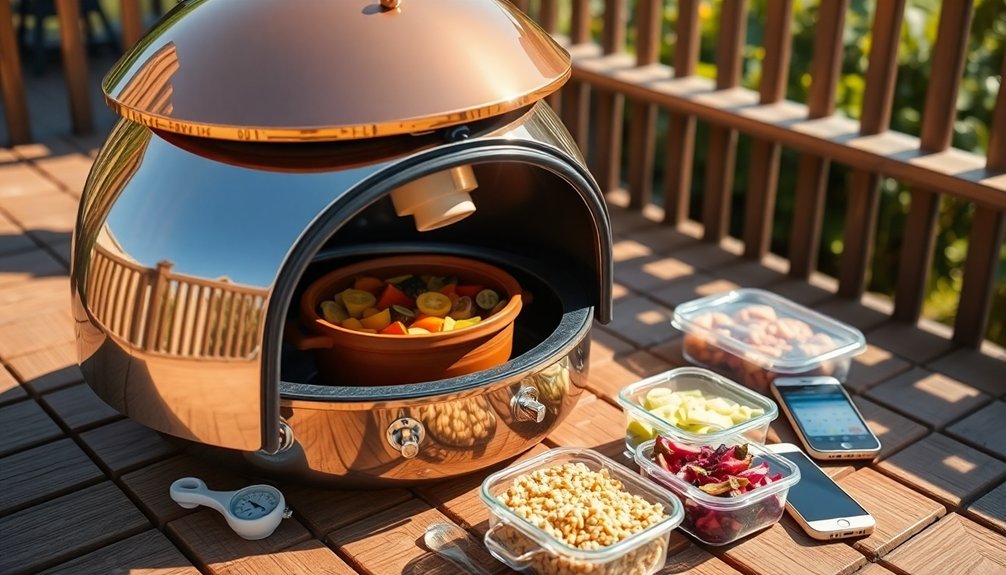Start your solar cooking journey early, between 10 a.m. and 4 p.m., when sunlight is strongest. You'll save significant time by prepping ingredients the night before and storing them in airtight containers. Track the sun's movement to optimize your cooking schedule, and use multiple dark-colored containers with tight-fitting lids to cook several dishes simultaneously. Plan your meals around weather forecasts, keeping backup options ready for cloudy days. Smart container selection, like flat-bottomed pots with vertical sides, guarantees even heating. Monitor temperatures regularly using reliable thermometers to maintain food safety. These proven strategies will transform your outdoor cooking experience.
Start Early Morning Hours

Since solar ovens perform at their best between 10 a.m. and 4 p.m., you'll want to begin your meal preparation during the early morning hours.
Starting early guarantees you'll have enough sunlight to complete your cooking, especially when preparing dishes that require longer cooking times like beans, lentils, or roasts.
Your solar oven can quickly reach temperatures near 300 degrees when positioned correctly in direct sunlight.
To maintain ideal cooking temperatures of 325-350 degrees, you'll need to adjust your oven periodically to follow the sun's movement.
This early start approach lets you cook confidently, knowing you won't run out of daylight before your meal is ready.
Plus, you can maximize your oven's potential by cooking multiple dishes simultaneously while attending to other tasks.
For maximum efficiency during cooking, use dark, non-reflective cookware to ensure optimal heat absorption and consistent cooking results.
Prep Food The Night Before
Making the most of your morning solar cooking starts with smart preparation the night before. You'll want to plan your recipes, chop ingredients, and store them in airtight containers. Select dark, non-reflective cookware to maximize heat absorption and guarantee all vessels are clean and ready for immediate use. Cutting food smaller helps food cook more efficiently in your solar oven.
| Task | Timing |
|---|---|
| Recipe Selection | Evening |
| Ingredient Prep | After Dinner |
| Solar Oven Setup | Before Bed |
Position your solar oven in a convenient spot, facing where the sun will rise. Make sure it's on a stable surface and properly secured. Don't forget to seal the oven to trap heat effectively. If someone else will be monitoring the cooking process, leave clear instructions about timing and any necessary adjustments they'll need to make during the day.
Track Sun Movement Patterns

To maximize your solar cooking efficiency, understanding the sun's daily movement patterns is essential.
You'll want to track the sun's path using simple observation methods like monitoring shadows throughout the day. Consider mounting sensors that can help you pinpoint the sun's exact position, or use a basic mechanical tracking system with a movable shade to guide your solar cooker's alignment. Time management skills are crucial for planning your meals around peak sun hours. For cloudy days, implement a clock-based backup system to maintain ideal positioning.
- Feel confident knowing exactly when to start cooking by understanding the sun's predictable daily arc
- Experience the satisfaction of harnessing nature's power through precise solar tracking
- Save precious time by positioning your cooker correctly the first time
- Enjoy peace of mind with automated tracking systems that do the work for you
Multiple Dish Cooking Strategy
When planning solar-cooked meals, you'll maximize efficiency by strategically coordinating multiple dishes throughout the day.
Cook during peak sun hours (11:00 am to 3:00 pm) and start with foods that require longer cooking times, like brown rice and beans. You can prep ingredients in the morning and tackle main dishes in the afternoon.
Match your recipes to your solar cooker type. Use parabolic cookers for quick stovetop-style cooking, box ovens for baking, and glass tube cookers for faster results. Popular dishes like chicken rice casserole adapt perfectly to any solar cooker model.
Select recipes similar to slow-cooker meals, as they adapt well to solar cooking. Remember to reduce liquid content since evaporation is slower in solar cookers.
Plan ahead and cook in batches when possible. You can multitask between cooking steps and even split meal preparation across two days if needed.
Weather-Based Meal Planning

Check your local weather forecast before planning your weekly menu to align meals with expected temperatures and conditions.
You'll want to keep a few alternative recipes ready for sudden weather changes, like having both indoor and outdoor cooking options during unpredictable spring days.
Stock your freezer with quick-prep backup meals for those times when unexpected storms or heat waves derail your original dinner plans.
Forecast-Based Recipe Selection
Planning your meals around weather forecasts and seasonal ingredients can revolutionize your sun-powered cooking routine. You'll save money by choosing produce at peak availability while ensuring maximum nutritional value.
When you match recipes to weather conditions, you're creating meals that naturally align with your body's cravings – like invigorating salads on scorching days or warming soups when it's chilly.
- Imagine biting into a perfectly ripe, local tomato that's bursting with summer flavor
- Picture serving a steaming bowl of homemade soup just as storm clouds gather
- Feel the satisfaction of pulling a colorful sheet pan dinner from the oven
- Experience the joy of sharing fresh, seasonal meals with loved ones
Consider prepping ingredients ahead based on the weekly forecast, and group recipes that share common items to minimize waste and shopping trips.
Alternative Meal Ready Options
Having backup meal options ready for unpredictable weather can make all the difference in maintaining your sun-powered cooking routine. When clouds roll in, you'll want convenient alternatives that don't compromise on quality or nutrition.
Consider subscribing to prepared meal delivery services like Factor or Home Chef, which offer ready-made options starting at $6.49 per meal. You can stock your freezer with their oven-ready meals that need minimal prep time, typically 25-35 minutes.
For even quicker solutions, try Home Chef's Express meal kits that you can prepare in just 10-15 minutes.
Don't overlook the convenience of frozen vegetables and pre-chopped ingredients. These time-savers work perfectly for impromptu stir-fries or quick salads when sun cooking isn't possible.
Keep your pantry stocked with these alternatives to guarantee you're never caught off guard by unexpected weather changes.
Smart Container Selection
When preparing solar-powered meals, you'll want to use dark-colored pots and containers that maximize heat absorption from the sun's rays.
You can boost cooking efficiency by selecting tight-fitting lids that lock in heat and moisture while preventing temperature loss.
To handle multiple dishes at once, try using a combination of different-sized containers that distribute heat evenly throughout your solar cooking setup.
Dark Pots Absorb Heat
Since dark pots absorb more heat than their lighter counterparts, they're ideal for maximizing efficiency in your sun-powered cooking.
Black containers excel at capturing infrared energy and light radiation, helping you reduce cooking time considerably. When you're using solar power, every bit of heat absorption matters, and dark-colored pots will give you the best results for browning and even heating.
- Experience the satisfaction of perfectly browned dishes using nature's energy
- Save precious time during meal prep while harnessing the sun's power
- Feel confident knowing you're maximizing your solar cooker's potential
- Enjoy the peace of mind that comes with efficient, sustainable cooking
Choose black steel pans for superior thermal conductivity and heat absorption.
You'll notice faster heating times and better browning results compared to lighter-colored or glass containers, especially when direct sunlight is available.
Proper Lid Selection Matters
The right lid can make or break your solar cooking success, just as dark pots maximize heat absorption. You'll want to use lids for most dishes to retain heat and moisture, facilitating even and efficient cooking throughout your meal preparation.
| Lid Usage Guidelines | Recommendations |
|---|---|
| General Cooking | Use lids to maintain consistent temperature |
| Baked Goods | Skip lids for proper air circulation |
| Material Choice | Select heat-resistant, insulating materials |
| Sealing | Guarantee tight fit to prevent heat escape |
| Enhancement | Add foil or reflective material underneath |
For safety, verify your solar oven reaches at least 180°F when cooking meat. While most dishes benefit from lids, certain baked goods like bread and cookies need airflow to achieve the right texture. You can boost efficiency by adding reflective materials to your lid's underside, directing more heat back into your food.
Multi-Container Heat Distribution
Smart container selection plays an essential role in maximizing your solar cooking efficiency. You'll achieve the best results by choosing black or dark-colored containers that absorb solar energy effectively.
Flat-bottomed pots with vertical sides and tight-fitting lids will help maintain consistent temperatures throughout the cooking process. When using multiple containers, you can overlap cooking schedules to make the most of available sunlight, especially with solar-powered electric pressure cookers.
- Experience the satisfaction of preparing multiple dishes simultaneously while harnessing pure solar energy
- Feel confident knowing your meals will continue cooking even during brief cloudy periods
- Enjoy the freedom of cooking various dishes without waiting for one to finish first
- Take pride in your eco-friendly cooking methods that save both time and energy
Temperature Monitoring Methods
Precise temperature monitoring forms the backbone of successful solar cooking. You'll get the most accurate readings by using buffered probe sensors rather than relying on air temperature measurements. For reliable data, use thermocouples and data loggers to track temperatures throughout your cooking process.
To maintain accuracy, shield your thermometers from direct sunlight while ensuring proper airflow. When measuring pot contents, use mercury thermometers with 1°C precision, and don't forget to secure silicon rubber gaskets to prevent heat loss.
Track your cooking temperatures in real-time using mobile apps that can display data and alert you when temperatures drift outside your target range. Remember to note environmental factors like wind and cloud cover, as they'll affect your cooking times and temperature maintenance.
Frequently Asked Questions
Can Frozen Food Be Cooked Directly in a Solar Cooker?
Yes, you can cook frozen food directly in your solar cooker. Just place it early in the morning, and as the sun heats the cooker to 200-300°F, it'll safely cook your frozen items.
What Happens if Animals Are Attracted to the Cooking Smells?
You'll need to take precautions since animals can be drawn to cooking smells. Create a separate cooking area away from your camp, store food properly, and dispose of scraps carefully to minimize wildlife encounters.
How Do You Clean and Maintain a Solar Cooker Properly?
You'll need to regularly wipe the reflective surface with a soft cloth, clean the cooking chamber using mild soap, and dry all parts thoroughly. Don't forget seasonal inspections and repairs to maintain peak performance.
Is It Safe to Leave Food Cooking Unattended in a Solar Cooker?
You can safely leave food unattended in your solar cooker if you've properly positioned it, checked the weather, and confirmed temperatures stay above 140°F. However, you'll need more frequent adjustments during non-summer seasons.
Can Solar Cookers Be Used Effectively in High-Altitude Locations?
Yes, you'll find solar cookers work effectively at high altitudes. You'll actually benefit from increased direct solar radiation due to less atmospheric interference, though you'll need to adjust cooking times for the lower boiling point.
In Summary
You'll find these seven time-saving strategies transform your solar cooking experience from a slow, unpredictable process into an efficient, reliable method of meal preparation. By implementing early starts, advance prep, sun tracking, and smart planning techniques, you're set up for consistent success. Don't forget to monitor temperatures and choose appropriate containers – these final steps guarantee you'll get the most from your sun-powered kitchen every time.





Leave a Reply